On Saturday afternoon, US intelligence officials leaked an assessment: the Assad regime, which has ruled Syria for over half a century, could very well collapse in a manner of days. As one official told CNN, “Probably by next weekend the Assad regime will have lost any semblance of power.”
It turns out that Washington was giving Assad too much credit. Less than eight hours later, a regime that had locked up hundreds of thousands of prisoners in dudgeons across the country, and used chemical weapons against its own people on multiple occasions to keep itself in power, was burning up and heading for the ash heap of history. The Syrian army gave up; its soldiers discarded their uniforms; Damascus fell without a fight; Bashar al-Assad took a plane to Moscow to save his skin; and the victorious rebels, suddenly thrust into power, were attempting to manage a peaceful political transition.
Assad, for all his many flaws, was also seen in Washington as a counterbalance to the jihadists that would take over the country
Viewed from Washington, the feelings were bittersweet. As national security advisor Jake Sullivan said days before the Assad family was deposed, nobody would cry for the House of Assad, backed up for over a decade by Russia and Iran. Assad’s Syria, after all, was the key corridor through which the Iranians sent Hezbollah all types of weapons, from precision-guided munitions and drones to anti-tank missiles to do battle against Israel. This was also the same regime that turned Damascus into a way-station for jihadists eager to travel to Iraq to kill US troops after Washington invaded that country more than two decades ago.
Yet Assad, for all his many flaws, was also seen in Washington as a counterbalance to the jihadists that would take over the country and perhaps cause even more problems for the United States and the Middle East writ large. Sullivan, in his remarks in California, expressed concern that the immediate power vacuum in a post-Assad Syria could add life to a relatively dormant Islamic State, whose territorial caliphate in Syria and Iraq was destroyed in 2019 under the weight of US airstrikes and ground operations from Syrian Kurds, the Iraqi army and Iranian-backed Shia militia groups. The Obama administration had a similar view years earlier; one of the reasons President Obama didn’t enforce his infamous red-line and bomb Syrian government facilities after Assad gassed the Damascus suburbs was because jihadist armed groups in the area would have likely have benefited.
The US, therefore, will take a wait-and-see approach. The Biden administration has been relatively muted over the last two days, issuing boilerplate statements about the president receiving briefings on the situation. In remarks on Sunday, President Biden applauded Syrians for bringing down a dictator, while emphasizing the fraught days ahead. A senior US administration official told reporters that Washington was in contact with all armed groups.
US officials looked like they were at a loss in these early hours of Assad’s fall. To be fair, you can’t blame them for feeling a little overwhelmed. Syria was a hard problem to begin with and there was never going to be an easy “made in America” solution to manage it. Even if there were easy options, the US would be wise to keep them on the shelf. Time and again, well-meaning US officials, driven by naïveté, hubris and gross self-confidence about their faculties, have deluded themselves into thinking they can create a better political future for this region. And time and again — Iraq in 2003, Libya in 2011, and Syria during the first years of the nearly fourteen-year civil war — they’ve failed and made things exponentially more complicated.
The international community hasn’t been much better. Outside of negotiating aid packages to areas of Syria outside of Assad’s control, the United Nations was unable to resolve Syria’s civil war due to intense disagreements between the United States and Russia, who backed opposing sides. A UN Security Council Resolution designed to bring the war to a close through the establishment of an interim government of national unity, the writing of a new constitution and free elections was a useless document which gathered dust. Confident in Russian and Iranian military, economic and diplomatic support, the stubborn Assad had no reason to dilute his own power for the sake of an opposition he viewed as terrorists.
In the end, this proved to be fatal for Assad and the regime his late father, Hafez, created in the early 1970s. Assad’s confidence in Russia and Iran, two countries distracted with bigger problems and tired of underwriting an ungrateful partner, was as misplaced as it was dangerous to his own self-preservation.
Syria is now in a moment of transition. Transitions can go well or poorly. Right now, Abu Mohammed al-Jolani, the head of the Hayat Tahrir al-Sham (HTS) rebel movement, is saying all the right things. During a speech at the Umayyad mosque in Damascus, Jolani, who still has a $10 million US bounty on his head, called the downfall of Assad a victory for Syrians of all sects, religions and regions. The former al-Qaeda member-turned de-facto head-of-state is engaging in a media blitz, trying to convince the West that HTS is interested in building a new Syria, not attacking infidels.
The United States, however, won’t be taking those words for granted. The best case scenario is the emergence of a Syria that is somewhat stable, where the focus remains on keeping the boot on Isis’s neck. The worst-case scenario is rebel infighting leading to sectarian-based cantons, anarchy and an uptick in jihadist activity. It’s too early to say which side of the coin Syria will land on.
























